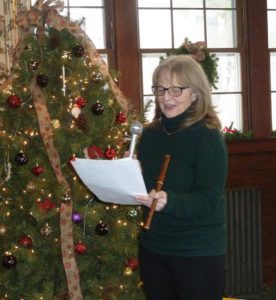Deb Burns on the Songs of the Suffrage Movement
By Julie Mackaman

Deb Burns lead sing-along at AAUW Holiday Party
For a moment, the room itself seemed to hold its breath. Deb Burns, the band’s whistle player, stood up, faced the audience, and said a few words about “The Women Are Coming,” a suffragist song dating back to 1913. It was our AAUW holiday party in the year of the Suffrage Centennial. Starting with a single pitch from her recorder, Deb led us on a musical journey through a half dozen songs that, more than a century ago, were sung in parlors, marches, demonstrations and prisons. And now they came to life once again in Bennington’s Old First Church Barn, sung by women who are continuing the march toward equity in a new millennium.
A Williamstown-based musician, painter, writer and editor, Deb began collecting suffragist songs in Spring 2019 in anticipation of a ceremony at our neighboring town’s public library, a tree planting to mark the centennial of Massachusetts’ ratification of the 19th Amendment. Since that initial singalong, Deb has been invited to lead singing at events ranging from suffrage commemorations and a Fourth of July parade of marching women all dressed in white, to the AAUW holiday party last December. On August 26, she will once again lead us in song at the Park McCullough House at the premiere of our suffrage-era fashion show video, From Corsets to Combinations, for which she also provided the soundtrack.
While Deb is a frequent performer of music, she says what she loves best is group singing. She speculates that singing may be the forerunner of language, in prehistoric times giving humans a way to communicate and, in ancient times, to hand down lore more easily remembered when set to a rhythmic melody. “Everyone can sing,” she says, adding with a laugh: “It’s our birthright.”
According to Deb, suffragists drew upon the power of music to unify, build community and “make noise” that would encourage and empower each other. She says that music has played a central role in every political movement, including universal struggles for equality that overlap with women’s rights. Deb fittingly replaces the more common term “Women’s Suffrage” with Woman Suffrage, the designation she says was used by suffragists themselves and that draws a linguistic parallel with Human Suffrage.
Suffragist lyricists set their words to popular tunes, often based on Scottish and Irish airs, so that they could easily be taught, sung and remembered. Writer and lecturer on social reform Charlotte Perkins Gilman, for example, respectively chose “Did You Ever See a Lassie,” “Bonnie Dundee” and “The Campbells Are Coming” for her songs “Another Star” (1911), “Let Us Go Free” (1913) and the “The Women Are Coming,” chosen by Deb to open our holiday party’s singalong. Deb explains that the intentionally simple and accessible lyrics quickly bonded marchers together in a collective voice.
The lyrics offer insight into the movement’s political strategy, which aimed to win over the support of the only group of Americans who could secure the vote for them: men. For if they wanted to “turn the handles of the pot,” that is, to bend the male decision-making apparatus toward favoring the suffrage campaign, women needed to “spin” their message. The songwriters therefore drew upon the reassuring tropes of the home and hearth — mothers and wives, babies, household order and serenity — to make their call for voting rights less threatening. The message is overt in the chorus of “Another Star”:
A Ballot for the Lady!
For the Home and for the Baby
Come, Vote ye for the Lady,
The Baby and the Home!
Other songs, such as Adella Hunt Logan’s “Just As Well As He” (1912, to the tune of “Coming Through the Rye”), compared the compatible roles of men and women in the home and in the nation:
If a home that has a father
Needs a mother too,
Then every state that has men voters
Needs its women too.
While the overarching political message was that the women’s vote would support, not disrupt, societal norms, several songs were as much a battle cry as an attempt to persuade. “The March of the Women” (1910, lyrics by Cicely Hamilton) and the much earlier “Daughters of Freedom, The Ballot Be Yours” (1871, lyrics by George Cooper) had a fanfare flourish and militaristic imagery. But even here, their message was that women want to join men, not conduct a war against them. “Bread and Roses,” a labor organizing song that — like the decades later “Union Maid” (1940, lyrics by Woody Guthrie) — shows the overlap between the women’s and labor movements, is explicit:
As we come marching, marching, we battle too, for men,
For they are in the struggle and together we shall win.
The campaign for women’s right to vote began before its formal launch in 1848 in Seneca Falls, New York, and the march for equality has continued long after the 19th amendment was ratified on August 18, 1920. The songs of the suffrage movement, especially when we sing them together, remind us of what’s at stake, raise our spirits, and stiffen our resolve. As one of the stewards of these songs, and of the tradition of singing them as a group, Deb Burns connects us with the living spirit of our history and our future.
For a sample of suffrage songs: Songs of the Suffragettes by Elizabeth Knight, recorded in 1958
Return to Table of Contents
